pcolaboy
Hero Member
Found a couple of items at a 18th-19th century shipyard site that has me stumped. I'll give you a little background first... this site was used for careening sailing ships as well as pulling them completely out of the water upright on a marine railway. The site was used by the Spanish, French, British, and early American shipwrights running from the early 1700's until the early 1800's. There are at least two confirmed British shipwrecks dating to the late 1700's less than 100 yards offshore from where I found these items buried in the sand onshore.
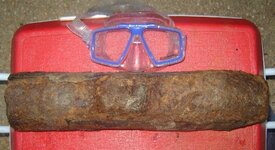
Item "A" is approximately 18" in length, 4 inches wide, 4 inches tall, and weighs nearly 80lbs. It is most certainly solid iron.
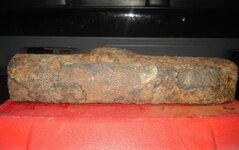
Front view of Item "A". I have been doing a combination of electrolysis and naval jelly to gently remove the concretions. Notice the upward blob of material on the top center of the object. The blob is all good metal and had little concretion on it when found.
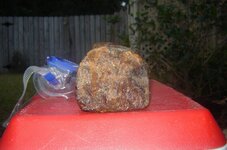
Left side of Item "A". No markings found on the item. Notice how it is flat on the bottom and rounded at the top resembling the shape of a loaf of bread. Iron ingot?
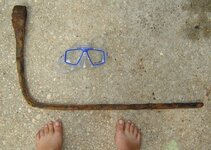
This is an iron rod that I found nearby just a few feet from shore with one end poking up slightly. I have only gently bumped this object with a rubber mallet to remove the heavy encrustations. I plan to perform electrolysis and naval jelly treatment if it is determined to be interesting.
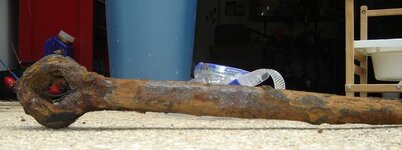
Closeup of the upper left of the rod showing the eye. This eye measures approximately 1" in diameter.
Any suggestions on what these may be would be appreciated. I'm short on room in the garage as it is.
Thanks,
Pcola
UPDATE: I took the items to our historical preservation group and the head archaeologist was very excited to be receiving them. She did confirm as some of you mentioned that the ingot-type object is in fact Iron Ballast from our local British period (1763-1781). She also believes that the iron rod object to be part of the rudder assembly for a longboat or gig from approximately the same period. The items will undergo proper preservation and eventually go on display at the T.T. Wentworth Florida State Museum in downtown Pensacola. Thanks for all the great information folks! You guys/gals are the best!
UPDATE 6/29/07: Received an official letter today from the Pensacola Historical Society. The artifacts I found are now under study by the Florida Archaeology Network group and have received further positive identification.

Item "A" is approximately 18" in length, 4 inches wide, 4 inches tall, and weighs nearly 80lbs. It is most certainly solid iron.

Front view of Item "A". I have been doing a combination of electrolysis and naval jelly to gently remove the concretions. Notice the upward blob of material on the top center of the object. The blob is all good metal and had little concretion on it when found.

Left side of Item "A". No markings found on the item. Notice how it is flat on the bottom and rounded at the top resembling the shape of a loaf of bread. Iron ingot?

This is an iron rod that I found nearby just a few feet from shore with one end poking up slightly. I have only gently bumped this object with a rubber mallet to remove the heavy encrustations. I plan to perform electrolysis and naval jelly treatment if it is determined to be interesting.

Closeup of the upper left of the rod showing the eye. This eye measures approximately 1" in diameter.
Any suggestions on what these may be would be appreciated. I'm short on room in the garage as it is.
Thanks,
Pcola
UPDATE: I took the items to our historical preservation group and the head archaeologist was very excited to be receiving them. She did confirm as some of you mentioned that the ingot-type object is in fact Iron Ballast from our local British period (1763-1781). She also believes that the iron rod object to be part of the rudder assembly for a longboat or gig from approximately the same period. The items will undergo proper preservation and eventually go on display at the T.T. Wentworth Florida State Museum in downtown Pensacola. Thanks for all the great information folks! You guys/gals are the best!
UPDATE 6/29/07: Received an official letter today from the Pensacola Historical Society. The artifacts I found are now under study by the Florida Archaeology Network group and have received further positive identification.



